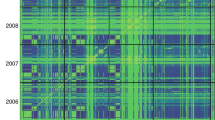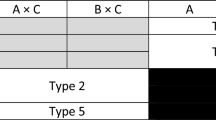Abstract
Maize (Zea mays L.) breeders evaluate many single-cross hybrids each year in multiple environments. Our objective was to determine the usefulness of genomewide predictions, based on marker effects from maize single-cross data, for identifying the best untested single crosses and the best inbreds within a biparental cross. We considered 479 experimental maize single crosses between 59 Iowa Stiff Stalk Synthetic (BSSS) inbreds and 44 non-BSSS inbreds. The single crosses were evaluated in multilocation experiments from 2001 to 2009 and the BSSS and non-BSSS inbreds had genotypic data for 669 single nucleotide polymorphism (SNP) markers. Single-cross performance was predicted by a previous best linear unbiased prediction (BLUP) approach that utilized marker-based relatedness and information on relatives, and from genomewide marker effects calculated by ridge-regression BLUP (RR-BLUP). With BLUP, the mean prediction accuracy (r MG) of single-cross performance was 0.87 for grain yield, 0.90 for grain moisture, 0.69 for stalk lodging, and 0.84 for root lodging. The BLUP and RR-BLUP models did not lead to r MG values that differed significantly. We then used the RR-BLUP model, developed from single-cross data, to predict the performance of testcrosses within 14 biparental populations. The r MG values within each testcross population were generally low and were often negative. These results were obtained despite the above-average level of linkage disequilibrium, i.e., r 2 between adjacent markers of 0.35 in the BSSS inbreds and 0.26 in the non-BSSS inbreds. Overall, our results suggested that genomewide marker effects estimated from maize single crosses are not advantageous (compared with BLUP) for predicting single-cross performance and have erratic usefulness for predicting testcross performance within a biparental cross.


Similar content being viewed by others
References
Albrecht T, Wimmer V, Auinger H-J, Erbe M, Knaak C, Ouzunova M, Simianer H, Schon C-C (2011) Genome-based prediction of testcross values in maize. Theor Appl Genet 123:339–350
Asoro FG, Newell MA, Beavis WD, Scott MP, Jannink JL (2011) Accuracy and training population design for genomic selection on quantitative traits in elite North American oats. Plant Genome 4:132–144
Barrett JC, Fry B, Maller J, Daly MJ (2005) Haploview: analysis and visualization of LD and haplotype maps. Bioinformatics
Bernardo R (1993) Estimation of coefficient of coancestry using molecular markers in maize. Theor Appl Genet 85:1055–1062
Bernardo R (1994) Prediction of maize single-cross performance using RFLPs and information from related hybrids. Crop Sci 34:20–25
Bernardo R (1996a) Best linear unbiased prediction of maize single-cross performance. Crop Sci 36:50–56
Bernardo R (1996b) Best linear unbiased prediction of the performance of crosses between untested maize inbreds. Crop Sci 36:872–876
Bernardo R, Yu J (2007) Prospects for genomewide selection for quantitative traits in maize. Crop Sci 47:1082–1090
Bernardo R, Jung HJ, Massman JM, Lewis ML, Lorenzana RE (2011) Strategies for using molecular markers to simultaneously improve corn grain yield and stover quality for cellulosic ethanol. XXII EUCARPIA Maize and Sorghum Conference, 19–22 June 2011, Opatija, Croatia, p 62
Calus MPL, Meuwissen THE, de Roos APW, Veerkamp RF (2008) Accuracy of genomic selection using different methods to define haplotypes. Genetics 178:553–561
Ching A, Caldwell KS, Jung M, Dolan M, Smith OS, Tingey S, Morgante M, Rafalski AJ (2002) SNP frequency, haplotype structure and linkage disequilibrium in elite maize inbred lines. BMC Genet 3:19
Dekkers JCM (2007) Prediction of response to marker-assisted and genomic selection using selection index theory. J Anim Breed Genet 124:331–341
Dekkers, JCM, Garrick DJ, Fernando RL (2009) Use of high-density SNP genotyping for genetic improvement of livestock. http://www.ans.iastate.edu/stud/courses/short/2009/. Iowa State Univ, Ames
Glaubitz J, Elshire R, Pasternak S, Olson A, Stein J, Guill K, Bottoms C, McMullen M, Ware D, Buckler E (2011) Improving the B73 reference genome via genotyping by sequencing (GBS). In: 53rd Annual Maize Genetics Conference, 17–20 March 2011, Saint Charles, Illinois, p 49
Goddard M (2009) Genomic selection: prediction of accuracy and maximisation of long term response. Genetica 136:245–257
Guo Z, Tucker DM, Lu J, Kishore V, Gay G (2012) Evaluation of genome-wide selection efficiency in maize nested association mapping populations. Theor Appl Genet 124:261–275
Gupta PK, Rustgi S, Mir RR (2008) Array-based high-throughput DNA markers for crop improvement. Heredity 101:5–18
Habier D, Fernando RL, Dekkers JCM (2007) The impact of genetic relationship information on genome-assisted breeding values. Genetics 177:2389–2397
Hallauer AR (1990) Methods used in developing maize inbreds. Maydica 35:1–16
Hayes BJ, Bowman PJ, Chamberlain AJ, Goddard ME (2009) Genomic selection in dairy cattle: progress and challenges. J Dairy Sci 92:433–443
Heffner EL, Jannink JL, Iwata H, Souza E, Sorrells ME (2011a) Genomic selection accuracy for grain quality traits in biparental wheat populations. Crop Sci 51:2597–2606
Heffner EL, Jannink JL, Sorrells ME (2011b) Genomic selection accuracy using multifamily prediction models in a wheat breeding program. Plant Genome 4:65–75
Henderson CR (1984) Applications of linear models in animal breeding. University of Guelph Ontario, Canada
Lee M, Sharopova N, Beavis WD, Grant D, Katt M, Blair D, Hallauer A (2002) Expanding the genetic map of maize with the intermated B73 × Mo17 (IBM) population. Plant Mol Bio 48:453–461
Lorenzana RE, Bernardo R (2009) Accuracy of genotypic value predictions for marker-based selection in biparental plant populations. Theor Appl Genet 120:151–161
Luan T, Woolliams JA, Ødegård J, Marin N, Meuwissen THE (2012) Contribution of genome-wide IBD to the accuracy of genomic selection. Plant Animal Genome Conference 14–18 January 2012, San Diego, California
Meuwissen THE, Hayes BJ, Goddard ME (2001) Prediction of total genetic value using genome-wide dense marker maps. Genetics 157:1819–1829
Parisseaux B, Bernardo R (2004) In silico mapping of quantitative trait loci in maize. Theor Appl Genet 109:508–514
Stuber CW, Cockerham CC (1966) Gene effects and variances in hybrid populations. Genetics 54:1279–1286
van Eeuwijk FA, Boer M, Totir R, Bink M, Wright D, Winkler CR, Podlich D, Boldman K, Baumgarten A, Smalley M, Arbelbide M, ter Braak CJF, Cooper M (2010) Mixed model approaches for the identification of QTLs within a maize hybrid breeding program. Theor Appl Genet 120:429–440
Van Inghelandt D, Reif JC, Dhillon BS, Flament P, Melchinger AE (2011) Extent and genome-wide distribution of linkage disequilibrium in commercial maize germplasm. Theor Appl Genet 123:11–20
Xu S (2003) Estimating polygenic effects using markers of the entire genome. Genetics 163:789–801
Zhong S, Dekkers JCM, Fernando RL, Jannink J-L (2009) Factors affecting accuracy from genomic selection in populations derived from multiple inbred lines: a barley case study. Genetics 182:355–364
Author information
Authors and Affiliations
Corresponding author
Additional information
Communicated by C. Schön.
Electronic supplementary material
Below is the link to the electronic supplementary material.
Rights and permissions
About this article
Cite this article
Massman, J.M., Gordillo, A., Lorenzana, R.E. et al. Genomewide predictions from maize single-cross data. Theor Appl Genet 126, 13–22 (2013). https://doi.org/10.1007/s00122-012-1955-y
Received:
Accepted:
Published:
Issue Date:
DOI: https://doi.org/10.1007/s00122-012-1955-y




